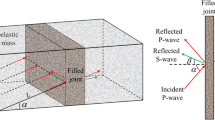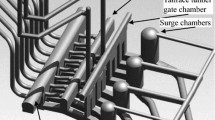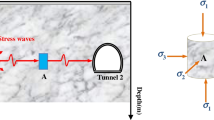Abstract
An analytical method for solving the dynamic response of an underground cavern with arbitrary shape in a viscoelastic rock mass under a plane P-wave is deduced based on the theory of stress wave and the method of complex function. The seismic quality factors are used to represent the viscoelastic behavior of the rock mass. The dynamic stress concentration factors (DSCF) of an arch-shaped cavern as example are discussed with considering different influencing parameters, e.g., seismic quality factors (under two frequencies) of surrounding rock mass, incident angle of incident plane P-wave, arch radius, and span height ratio of the cavern. The research result shows that the seismic quality factors of the surrounding rock mass are of significant importance for the scattering of the plane P-wave. The seismic quality factors of the surrounding rock mass change the distribution characteristics and scale of the DSCF compared with an elastic rock mass. Under the coupling effect of seismic quality factor and other effects, the change of DSCF around the cavern is more complex.







Similar content being viewed by others
References
Aki, K., Richards, P.G.: Quantitative Seismology: Theory and Methods, vol. 1. WH Freeman & Co, San Francisco (1980)
Cormier, V.F.: Seismic Attenuation: Observation and Measurement. In: James, D.E. (ed.) Geophysics, pp. 1005–1018. Springer, New York (1989)
Chai, S.B., Li, J.C., Rong, L.F., et al.: Theoretical study for induced seismic wave propagation across rock masses during underground exploitation. Geomech. Geophys. Geo-Energy Geo-Resour. 3(2), 95–105 (2017)
Davis, C.A., Lee, V.W., Bardet, J.P.: Transverse response of underground cavities and pipes to incident SV waves. Earthq. Eng. Struct. Dynam. 30(3), 383–410 (2001)
Deng, X.F., Zhu, J.B., Chen, S.G., Zhao, Z.Y., Zhou, Y.X., Zhao, J.: Numerical study on tunnel damage subject to blast-induced shock wave in jointed rock masses. Tunn. Undergr. Space Technol. 43, 88–100 (2014)
Dravinski, M., Michael, C.Y.: Peak surface motion due to scattering of plane harmonic P, SV, or Rayleigh waves by a rough cavity embedded in an elastic half-space. J. Seismolog. 15(1), 131–145 (2011)
Fang, X.Q., Zhang, T.F., Li, B.L., Yuan, R.J.: Elastic-slip interface effect on dynamic stress around twin tunnels in soil medium subjected to blast waves. Comput. Geotechn. 119, 103301 (2020)
Fang, X.Q., Jin, H.X., Wang, B.L.: Dynamic interaction of two circular lined tunnels with imperfect interfaces under cylindrical P-waves. Int. J. Rock Mech. Min. Sci. 79, 172–182 (2015)
Gatmiri, B., Eslami, H.: Scattering of harmonic waves by a circular cavity in a porous medium: complex functions theory approach. Int. J. Geomech. 7(5), 371–381 (2007)
Hashash, Y.M., Hook, J.J., Schmidt, B., et al.: Seismic design and analysis of underground structures. Tunn. Undergr. Space Technol. 16(4), 247–293 (2001)
Jiang, Y., Wang, C., Zhao, X.: Damage assessment of tunnels caused by the 2004 Mid Niigata prefecture earthquake using Hayashi’s quantification theory type II. Nat. Hazards 53, 425–441 (2010)
Johnson, P.A., Rasolofosaon, P.N.J.: Nonlinear elasticity and stress-induced anisotropy in rock. J. Geophys. Res. Solid Earth 101(B2), 3113–3124 (1996)
Jiang, X.Y.: Complex Variable Function Solution of Stress Field of Surrounding Rock in Coal Mine. Liaoning Technical University, Fuxin (2013). (in Chinese)
Liu, D.K., Gai, B.Z., Tao, G.Y.: Applications of the method of complex function to dynamic stress concentration. Wave Motion 4, 293–304 (1982)
Liu, Q., Zhang, C., Todorovska, M.I.: Scattering of SH waves by a shallow rectangular cavity in an elastic half space. Soil Dyn. Earthq. Eng. 90, 147–157 (2016)
Lee, V.W., Trifunac, M.D.: Response of tunnels to incident SH-waves. J. Eng. Mech. Div. 105(4), 643–659 (1979)
Li, J.C., Rong, L.F., Li, H.B., Hong, S.N.: An SHPB test study on stress wave energy attenuation in jointed rock masses. Rock Mech. Rock Eng. 52(2), 403–420 (2019)
Liu, Q., Zhao, M., Wang, L.: Scattering of plane P, SV or Rayleigh waves by a shallow lined tunnel in an elastic half space. Soil Dyn. Earthq. Eng. 49, 52–63 (2013)
Lucet, N., Zinszner, B.: Effects of heterogeneities and anisotropy on sonic and ultrasonic attenuation in rocks. Geophysics 57(8), 1018–1026 (1992)
Liang, J., Zhang, H., Lee, V.W.: A series solution for surface motion amplification due to underground twin tunnels: incident SV waves. Earthq. Eng. Eng. Vib. 2(2), 289–298 (2003)
Li, J.C., Li, N.N., Chai, S.B., et al.: Analytical study of ground motion caused by seismic wave propagation across faulted rock masses. Int. J. Numer. Anal. Meth. Geomech. 42(1), 95–109 (2018)
Pao, Y.H., Mow, C.C.: The Diffraction of Elastic Waves and Dynamic Stress Concentrations. Crane, Russak & Company Inc., New York (1973)
Shen, Y., Gao, B., Yang, X., Tao, S.: Seismic damage mechanism and dynamic deformation characteristic analysis of mountain tunnel after Wenchuan earthquake. Eng. Geol. 180, 85–98 (2014)
Wang, J.H., Zhou, X.L., Lu, J.F.: Dynamic stress concentration around elliptic cavities in saturated poroelastic soil under harmonic plane waves. Int. J. Solids Struct. 42(14), 4295–4310 (2005)
Wang, X., Yuan, W., Yan, Y.T., Zhang, X.: Scale effect of mechanical properties of jointed rock mass: a numerical study based on particle flow code. Geomech. Eng. 21(3), 259–268 (2020)
Wang, X., Li, J.C., Zhao, X.B., Liang, Y.: Propagation characteristics and prediction of blast-induced vibration on closely spaced rock tunnels. Tunn. Undergr. Space. Technol. 123, 104416 (2022)
Yi, C., Zhang, P., Johansson, D., et al.: Dynamic response of a circular lined tunnel with an imperfect interface subjected to cylindrical P-waves. Comput. Geotech. 55, 165–171 (2014)
Yu, X.F., Zheng, Y.R., Liu, H.H., Fang, Z.C.: Stability Analysis of Surrounding Rock of Underground Cavern. Coal Industry Press, Beijing (1983).. ((in Chinese))
Zhang, X.P., Jiang, Y.J., Sugimoto, S.: Seismic damage assessment of mountain tunnel: a case study on the Tawarayama tunnel due to the 2016 Kumamoto earthquake. Tunn. Undergr. Space Technol. 71(1), 138–148 (2018)
Zhang, X., Jiang, Y., Sugimoto, S.: Anti-plane dynamic response of a non-circular tunnel with imperfect interface in anisotropic rock mass. Tunn. Undergr. Space Technol. 87, 134–144 (2019)
Zhang, X., Jiang, Y., Chen, L., Wang, X., Golsanami, N., Zhou, L.: Anti-plane seismic performance of a shallow-buried tunnel with imperfect interface in anisotropic half-space. Tunnell. Undergr. Space Technol. 112, 103906 (2021)
Zhou, F., Cao, X.: Comparison between exact solutions and approximate solutions of deep tunnels. Appl. Math. Mech. 38(10), 1166–1179 (2017). ((in Chinese))
Acknowledgements
The research was supported by the Postgraduate Research & Practice Innovation Program of Jiangsu Province (No. KYCX19_0094); the Shandong Provincial Natural Science Foundation (No. ZR2020QE270); the Key Laboratory of Deep Earth Science and Engineering (Sichuan University), Ministry of Education, China (No. DESE202109).
Author information
Authors and Affiliations
Corresponding author
Ethics declarations
Conflict of interest
The authors declare that they have no conflict of interest.
Additional information
Publisher's Note
Springer Nature remains neutral with regard to jurisdictional claims in published maps and institutional affiliations.
Appendices
Appendix A
Coefficients of \(E_{n}^{(11)}\), \(E_{n}^{(12)}\), \(E_{n}^{(21)}\), \(E_{n}^{(22)}\), \(E_{{}}^{(1)}\), and \(E_{{}}^{(2)}\) as presented in Eqs. (32) and (33)
Appendix B
Coefficients of R, b2, b3, b4, and b5 in Eq. (42):
where
\(c_{l1} = - \lambda_{l} \Phi_{l}\), \(c_{l2} = - \Phi_{l} \left[ {1 + \frac{{\lambda_{l}^{2} }}{2}\left( {\Phi_{l} - 1} \right)} \right]\), \(c_{l3} = \lambda_{l} \Phi_{l} \left( {\Phi_{l} - 1} \right)\left[ {1 + \frac{{\lambda_{l}^{2} }}{6}\left( {\Phi_{l} - 2} \right)} \right]\),
\(c_{l4} = \Phi_{l} \left( {\Phi_{l} - 1} \right)\left[ {\frac{1}{2} + \frac{{\lambda_{l}^{2} }}{2}\left( {\Phi_{l} - 2} \right) + \frac{{\lambda_{l}^{4} }}{24}\left( {\Phi_{l} - 2} \right)\left( {\Phi_{l} - 3} \right)} \right]\),
\(c_{l5} = { - }\lambda_{l} \Phi_{l} \left( {\Phi_{l} - 1} \right)\left( {\Phi_{l} - 2} \right)\left[ {\frac{1}{2} + \frac{{\lambda_{l}^{2} }}{6}\left( {\Phi_{l} - 3} \right) + \frac{{\lambda_{l}^{4} }}{1204}\left( {\Phi_{l} - 3} \right)\left( {\Phi_{l} - 4} \right)} \right]\), \(l\) = 1, 2, 3,
\(\lambda_{1} = 2\cos (k_{1} \pi )\), \(\lambda_{2} = 2\cos (k_{2} \pi )\), \(\lambda_{3} = 2\cos (k_{3} \pi )\),
\(\Phi_{1} = \frac{{v_{1} }}{\pi }{ - }1\), \(\Phi_{2} = \frac{{v_{2} }}{\pi }{ - }1\),\(\Phi_{3} = \frac{{v_{3} }}{\pi }{ - }1\),
\(v_{1} = \frac{3\pi }{2}{\text{ - arctan}}\frac{b - a}{{2h - H}}\), \(v_{2} = \pi + {\text{arctan}}\frac{b - a}{{2h - H}}\),\(v_{3} = \frac{3\pi }{2}\), and the value of \(k_{1}\),\(k_{2}\), \(k_{3}\) can be obtained by trial method according to the following equation:
Rights and permissions
About this article
Cite this article
Wang, X., Zhang, X.P. Dynamic stress concentration of a non-circular cavern in a viscoelastic medium subjected to a plane P-wave. Acta Mech 233, 1455–1466 (2022). https://doi.org/10.1007/s00707-022-03169-8
Received:
Revised:
Accepted:
Published:
Issue Date:
DOI: https://doi.org/10.1007/s00707-022-03169-8




